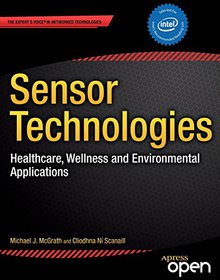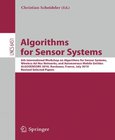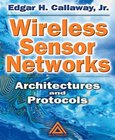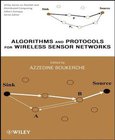Sensor Technologies
Healthcare, Wellness and Environmental Applications

Book Details:
| Publisher: | Apress |
| Series: | Apress |
| Author: | Cliodhna Ni Scanaill |
| Edition: | 1 |
| ISBN-10: | 1430260130 |
| ISBN-13: | 9781430260134 |
| Pages: | 336 |
| Published: | Dec 17 2013 |
| Posted: | Dec 30 2014 |
| Language: | English |
| Book format: | |
| Book size: | 7.78 MB |
Book Description:
Sensor Technologies: Healthcare, Wellness and Environmental Applications explores the key aspects of sensor technologies, covering wired, wireless, and discrete sensors for the specific application domains of healthcare, wellness and environmental sensing. It discusses the social, regulatory, and design considerations specific to these domains. The book provides an application-based approach using real-world examples to illustrate the application of sensor technologies in a practical and experiential manner. The book guides the reader from the formulation of the research question, through the design and validation process, to the deployment and management phase of sensor applications. The processes and examples used in the book are primarily based on research carried out by Intel or joint academic research programs. Sensor Technologies: Healthcare, Wellness and Environmental Applications provides an extensive overview of sensing technologies and their applications in healthcare, wellness, and environmental monitoring. From sensor hardware to system applications and case studies, this book gives readers an in-depth understanding of the technologies and how they can be applied. I would highly recommend it to students or researchers who are interested in wireless sensing technologies and the associated applications. Dr. Benny Lo Lecturer, The Hamlyn Centre, Imperial College of London This timely addition to the literature on sensors covers the broad complexity of sensing, sensor types, and the vast range of existing and emerging applications in a very clearly written and accessible manner. It is particularly good at capturing the exciting possibilities that will occur as sensor networks merge with cloud-based big data analytics to provide a host of new applications that will impact directly on the individual in ways we cannot fully predict at present. It really brings this home through the use of carefully chosen case studies that bring the overwhelming concept of 'big data' down to the personal level of individual life and health. Dermot Diamond Director, National Centre for Sensor Research, Principal Investigator, CLARITY Centre for Sensor Web Technologies, Dublin City University "Sensor Technologies: Healthcare, Wellness and Environmental Applications takes the reader on an end-to-end journey of sensor technologies, covering the fundamentals from an engineering perspective, introducing how the data gleaned can be both processed and visualized, in addition to offering exemplar case studies in a number of application domains. It is a must-read for those studying any undergraduate course that involves sensor technologies. It also provides a thorough foundation for those involved in the research and development of applied sensor systems. I highly recommend it to any engineer who wishes to broaden their knowledge in this area!" Chris Nugent Professor of Biomedical Engineering, University of Ulster What youll learnThe relevant sensing approaches and the hardware and software components required to capture and interpret sensor data. The importance of regulations governing medical devices. A design methodology for developing and deploying successful home- and community-based technologies, supported by relevant case studies. Health, wellness, and environmental sensing applications and how they work. The challenges and future directions of sensing in these domains. Who this book is for Sensor Technologies: Healthcare, Wellness and Environmental Applicationsis targeted at clinical and technical researchers, engineers, and students who want to understand the current state of the art in sensor applications in these domains. The reader gains a full awareness of the key technical and non-technical challenges that must be addressed in the development of successful end-to-end sensor applications. Real-world examples help give the reader practical insights into the successful development, deployment, and management of sensor applications. The reader will also develop an understanding of the personal, social, and ethical impact of sensor applications, now and in the future. Table of ContentsChapter One: Introduction Chapter Goal: Reader should understand the key challenges and drivers for sensor application development. The reader should also understand how sensor technologies can play a role in addressing some of the key challenges facing global society in the short to medium term. 1. Book overview 2. Drivers for Sensor Applications (Infrastructure Growth in Developing Countries, Advances in Energy Harvesting, New Applications, Cost reduction, Real-time monitoring of situations to avoid unplanned downtime, Security (personal and national), the internet of things). 3. Challenges for Sensor Applications (Power, Efficient Operation in Harsh Environments, Number of Deployable Nodes, Safety and Regulations, High Cost of Installation, Security and Reliability, sensor management) 4. Global Megatrends and the opportunities for sensing technologies o Water and Food Constraints o Aging Demographics o Public Health o Pandemics o Security Chapter 2: Sensing and Sensor Fundamentals Chapter Goal: Reader should understand existing sensor technologies, which can be used in healthcare, wellness, and environmental domains. They should also understand the role of smart sensors and smart phones as mobile sensing platforms and aggregators. 1. Sensing Modalities (Mechanical, MEMS, Optical, ISFET, TAS) 2. Sensing Domains (Air, Water, Noise, Bacterial, Chemical, Kinematic, DNA, Physiological) 3. Functional Characterisation of Sensors o Communication methods discrete, wired, wireless o Smart Sensors and Sensor Platforms MSP430 (SHIMMER and telosB motes) ATmega PIC 4. Smart Phones as mobile sensor platforms 5. Selecting and specifying sensors Chapter 3 Key Sensor Technology Components Hardware and Software Overview Chapter Goal: Reader should have a high level understanding of the key hardware and software components, which are necessary for the development of sensors systems and why technologies are selected for specific applications. 1. Overview Sensor systems 2. MCUs (TI MSP430, ATmega, PIC) a. ADCs b. Interrupts c. Real-time Clocks 3. Sensor Interfaces a. Digital b. Analog c. I2C 4. Communications wired and wireless interfaces RS232/485, USB, Ethernet, FieldbusProprietary Short Range Wireless Protocols (e.g. ANT, BodyLAN, Sensium)Standard Short Range Protocols i. IEEE 802.15.6 ii. Bluetooth/Smart Bluetooth iii. 802.15.4 iv. UWB Medium Range i. Wi-Fi 5. Data storage (EEPROM, sd card, data forwarding) 6. Power management and Energy Harvesting 7. Operating Systems and Software Development Environments (SDKs) Chapter 4 Sensor Network Architectures Chapter Goal: Reader should understand the various approaches to the design of sensor network architectures; scaling from body worn systems, to ambient sensing, to city-scale deployments. The reader should also understand the advantages and disadvantages of current and evolving sensor network architectures. 1. Sensor network architectures o Discrete Sensor o Sensor to aggregator o PAN/WPAN/smart clothing o Pervasive/Ambient sensor networks o Wide area networks (city-wide, country wide) 2. Challenges in developing and deploying sensor networks 3. Current and Proposed Solutions o Remote sensor management o Edge Processing o Power harvesting o New communication standards Chapter 5: Adding Vibrancy to Sensor Data Chapter Goal: Reader should understand the various methods to interpret and display sensor data to the user. They will understand the importance of creating a data analysis plan from the outset, and the different types of data analysis throughout the application stack. 1. Data Literacy How can we intuitively answer questions with sensor data and contextualise answers 2. Data Quality a. Calibration b. Trust and Repudiation 3. Sensor Fusion combining sensory data from disparate sources 4. Data Mining 5. Data Visualisation 6. Openness, data integration, virtual sensors 7. Exploiting the power of the cloud Chapter 6: Regulation and Standards Chapter Goal: Reader should understand the key technologies, which impact or influence the development of sensor deployment and applications including the emerging standards and regulatory considerations. 1. Regulatory Standards (US, EU, Japan) : why, which, and how standards impact your application 2. Regulatory Issues: Certification 3. Smartphones Considerations o Privacy and data security 4. Standards Bodies and Industry Groups o Continua Healthcare Alliance o ISO/IEEE 11073 5. Wearable Wireless Health Communication Standards Chapter 7: Biosensing in Everyday Life Driving Biocontextual Aware Computing Chapter Goal: Reader should understand the social relationships that create opportunities and barriers for widespread, consumer-based biosensing. The reader should understand how the social world is shifting from sensor technologies of should to sensor technologies of could to facilitate new understandings of health and wellness and drive new methods and practices of personal data sharing. 1. Data Security and Ownership - Sharing and Managing Personal Data 2. Game Changing Pressure for Affordable Healthcare 3. Continuous, Personal Data is Improving Lives 4. Emerging Tech-Empowered Citizens 5. Sensing for Self-Discovery, Culture and Play 6. User feedback/Supporting sustainable human behaviours leveraging the gaming culture Chapter 8: Development and Deployment of Sensor Technologies for Home and Community Settings Chapter Goal: Reader should understand how to design a sensor deployment for a home or community. The chapter informs the reader how to formulate the research question the deployment will address, how to develop prototypes, and manage and deploy them successful. The chapter will finish with exemplar case studies of real world sensor deployments. Study Design The Right QuestionHome Deployment ElementsHome Deployment ManagementThe Prototyping Design ProcessCase Studies Chapter 9: Body Worn and Ambient Sensor Applications for Assessment, Monitoring, and Diagnostics Chapter Goal: Reader should at the end of this chapter have an understanding of the key characteristics of how body worn and ambient sensor applications, and how they vary according to the domain in which they are deployed. The reader will be presented with the key challenges faced in each domain, and emerging solutions for these challenges. 1. Drivers and Inhibitors (Incidence of chronic diseases, aging demographics, Adjusting provider compensation, prevention, medical work practice changes) 2. Hospital based sensing for assessment and diagnosis 3. Supervised Assessment and Monitoring in Community Settings 4. Home Based Applications o Clinical grade sensing for patient monitoring o Body worn sensing (e.g. PERS) for monitoring and alerting o Passive sensing for monitoring and alerting (e.g. ADLs) 5. Key challenges Chapter 10: Wellness, Fitness and Lifestyle Chapter Goal: Reader should understand the key trends in how people use body worn sensors to manage their fitness and wellbeing. Key applications include: sensors for measuring activities in sports performance, activity/weight management and sleep tracking, 1. Drivers and Inhibitors 2. Sports and fitness applications (running, walking cycling, field sports) Vital signs and physiological parameters Fitness gaming Wii Fit, Kinect muscle movement, body stress levels, speed, distance, location Fitness Statistics and Analysis 3. Outdoor Activities o Pressure (mountaineer and paragliding) o GPS (hiking, cycling, golf) 4. Obesity and weight management 5. Sleep o Baby Monitoring o Sleep Quality health and social impacts o Sleep Apnoea Chapter 11: Environmental Monitoring for Health and Wellness Chapter Goal: Reader should understand how sensors and sensor networks are used for environmental monitoring, one of the key emerging applications domains. Apart from disaster monitoring, sensing also has the potential for air quality, weather monitoring, pollution etc.; with benefits for both urban and rural dwellers. 1. Drivers and Inhibitors o Correlations to health impacts 2. Home Sensing o Carbon Monoxide o Smoke Detectors o Passive Infrared (PIR) o Temperature o Sound o Sustainable Living 3. Smart Environments 4. Environmental Parameters (Noise, Water, Bacteria, Air Quality, Radiation, Urban Heat Islands) 5. Weather - Exceptional Event and Disaster Management Intelligence Chapter 12: Conclusions and Future Directions Chapter Goal: Reader should understand the key conclusions that the authors have outlined in the previous chapters. The reader should also gain an understanding of the key trends which will affect future sensor applications and how people will utilise these novel applications in their everyday lives. 1. Summary of the overall conclusions 2. Future Directions for Sensing o Use Centred Healthcare o Citizen centric sensing o Influence of urbanisation on health, wellness and lifestyle choices. o Sustainable human behaviour change
Download Link:
Related Books:
Algorithms for Sensor Systems
6th International Workshop on Algorithms for Sensor Systems, Wireless Ad Hoc Networks and Autonomous Mobile Entities
This volume contains the papers presented at ALGOSENSORS 2010, the 6th International Workshop on Algorithms for Sensor Systems, Wireless Ad Hoc Networks and Autonomous Mobile Entities, held on July 5, 2010 in Bordeaux, France. There were 31 submissions. Each submission was reviewed by four Program Committee members. The committee decided to accept 15 papers, among them two brief announcements. TheProgramCommitteewouldliketothankallwhosubmittedpapersandall the external reviewers who helped us evaluate the submissions. As the Program Chair of ALGOSENSORS 2010, I would like to express my deep gratitude to the Program Committee for all of their work during the paper review process and the fruitful discussions. I would also like to thank the Workshops Cha...
Wireless Sensor Networks
Architectures and Protocols
Because they provide practical machine-to-machine communication at a very low cost, the popularity of wireless sensor networks is expected to skyrocket in the next few years, duplicating the recent explosion of wireless LANs. Wireless Sensor Networks: Architectures and Protocols describes how to build these networks, from the layers of the communication protocol through the design of network nodes. This overview summarizes the multiple applications of wireless sensor networks, then discusses network device design and the requirements that foster the successful performance of these applications.The book discusses factors affecting network design, including the partitioning of node functions into integrated circuits, low power system design, power sour...
Algorithms and Protocols for Wireless Sensor Networks
A one-stop resource for the use of algorithms and protocols in wireless sensor networksFrom an established international researcher in the field, this edited volume provides readers with comprehensive coverage of the fundamental algorithms and protocols for wireless sensor networks. It identifies the research that needs to be conducted on a number of levels to design and assess the deployment of wireless sensor networks, and provides an in-depth analysis of the development of the next generation of heterogeneous wireless sensor networks.Divided into nineteen succinct chapters, the book covers: mobility management and resource allocation algorithms; communication models; energy and power consumption algorithms; performance modeling and simulation;auth...
2007 - 2021 © eBooks-IT.org



